|
A-26A Nimrod Conversion
Cutting Edge Modelworks
S u m m a r y
|
| Catalogue Number: |
CEC48039 - A-26A Nimrod
(A-26K Counter Invader) Conversion |
| Scale: |
1/48 |
| Contents and Media: |
Exterior modification for
Monogram kit to make Vietnam-era A-26A including wheels, props,
cowlings, pylons, wingtip fuel tanks, antennas, gun nose and
fin/rudder. |
| Price: |
USD$39.99 - available from
Meteor Productions website |
| Review Type: |
FirstLook |
| Advantages: |
Allows modeler to make an
accurate A-26A external configuration |
| Disadvantages: |
Basic kit not currently in
production; “Congo Mod” parts compromised by difficulty of making an
accurate part to easily fit the kit geometry. |
| Recommendation: |
Recommended |
Reviewed by Jim Rotramel

HyperScale is proudly sponsored by Meteor
Productions
For those too young to remember, the A-26A “Nimrod”
was the most effective night attack aircraft used on the Ho Chi Minh Trail
through Laos between June 1966 and November 1969. Flown out of Nakhon
Phanom Royal Thai AFB, the success of this WWII vintage attack bomber was
extremely embarrassing to the “jets can do everything” USAF leadership.
For example, in December 1966 of 3,000 sorties were flown against the Ho
Chi Minh Trail, Nimrods flew only 6.5% but accounted for 64% of the 195
trucks killed!
To fix this “problem” Gen. Momyer (7th AF) first insisted that the A-26As
be forced to use inappropriate ordnance (“hard” bombs or rockets and
napalm rather than cluster bombs) and, when that didn’t work, resorted to
lying about the bombing results by lumping all 7th AF kills together and
stating that the A-26 kills had happened in North Vietnam (where only jets
operated). He also refused all requests to increase the number of A-26As
used (there were never more than 18 in theater at any one time). Just one
more example of how winning wasn’t important to the military “leadership”
of the time. More ominously, despite repeated requests, the A-26As were
never upgraded with “Yankee” ejection seats (of 30 airframes sent to SEA,
12 were lost and only two of those crews survived).
So, if you want to do a model of an aircraft of that era flown by really
heroic crews, the Nimrod is a great candidate. Forty WWII vintage
airframes were modified from 15 June 1964 to 1 April 1965 and given new
serial numbers (64-17640 to 79). They had the gun turrets removed,
permanent tip tanks installed, bigger props, a bigger tail, new
wheels/tires, pylons, and antennas; and a new oil cooler/cowling that was
added later. Originally designated B-26K, they were redesignated as the
A-26A on 1 May 1966 before being sent to Thailand because the Thai
government objected to having aircraft with the “offensive” bomber
designation based on its territory.
So much for history,.
I am very pleased to report that the
long-anticipated Meteor A-26A exterior conversion set is no longer
vaporware! This kit is the result of the collaboration of a number of
Nimrod fans, including myself, Fotios Rouch, and Dave and Scotty from
Meteor (that I know of). We photographed and measured the real thing (at
both Pima and Wright-Patterson) and tried to answer all the nagging
questions about its configuration. Anyway, here are the kit parts and my
comments on them. By the way, this set is designed for the original “glass
nose” Monogram kit (5508) and NOT the later “gun nose” Pro Modeler kit,
which has a belly turret and somewhat different nose contours. You will
have many more problems with the Monogram kit than the Meteor update; it’s
hard to believe it was touted as “Kit of the Year” in 1993. It’s aged
about as well as Anna Nicole Smith…
Tail
The update includes not only a new rudder, which has
a chord extended by six inches, but a new tail cone, which makes the tail
one foot longer than the original, AND included as well is a new fin that
includes the vortex generators molded into its right side and an anti
collision beacon molded on the tip.
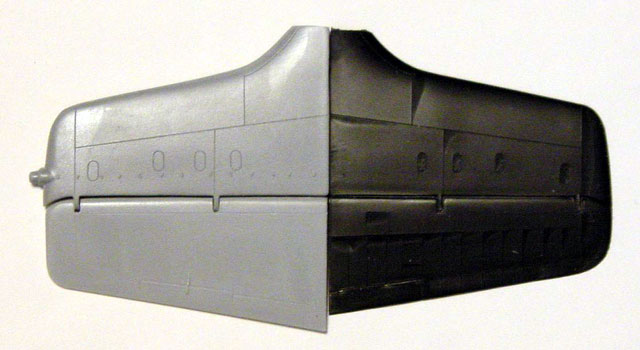
As it turns out, there were at least three
configurations of anti-collision beacon installations featuring differing
sizes and mounted in slightly different locations – Meteor chose one. (I
plan to replace the gray resin beacon with red plastic.)
Click the
thumbnails below to see two styles of tails:
The tail cone is by far the most challenging of all
the parts to cut free of its casting block and removing part of the kit
horizontal tail is the most difficult of all the cutting needing to be
done to the kit. That being said, anybody with moderate modeling skills
(like me) will have no serious problems.
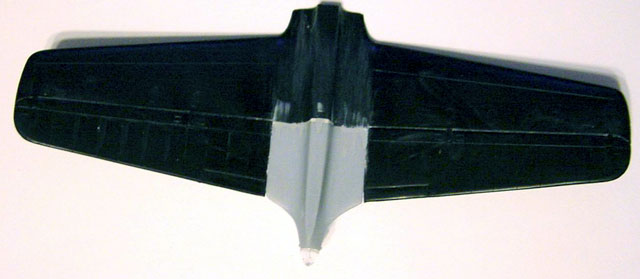
The tail cone is designed for you to use the clear
kit taillight. However, aside from the green and white prototypes, these
were virtually always painted over. I’m not so sure this was a good idea
because there are two tiny lights right at the join of the two parts and
the fit really isn’t that perfect, which means the lights could be
obliterated while sanding the joint smooth.
Propellers
A-26A propellers were DC-6 props cut down by 10
inches per blade (20-inch diameter). The Meteor props were based on actual
drawings provided by Hamilton Sundstrand. The biggest problems with the
propellers won’t be the Meteor parts, but the crankcase on the kit part --
the hole for the propeller pin isn’t centered in the crankcase. I plan to
use tubing centered in the part.
The Meteor kit includes resin propeller shafts, but
the kit “propeller pins” will also fit the resin hubs. One other problem
with the Monogram kit: the exhaust manifolds are molded onto the back of
the cowl flaps, making the cowl flaps too thick and the exhaust stacks
invisible.
Engine Cowlings
Many, but not all, of the A-26As used in SEA were
fitted with “Congo Mod” cowlings with a distinctive new oil cooler
configuration. Meteor was faced with a challenge in replicating this
feature because the real item would extend across three kit parts and be
prohibitively expensive to produce (and this is already a pretty expensive
set).
Click the
thumbnails below to view larger images of the oil cooler:
While it isn’t precisely accurate, it is pretty good
representation of the Congo Mod.
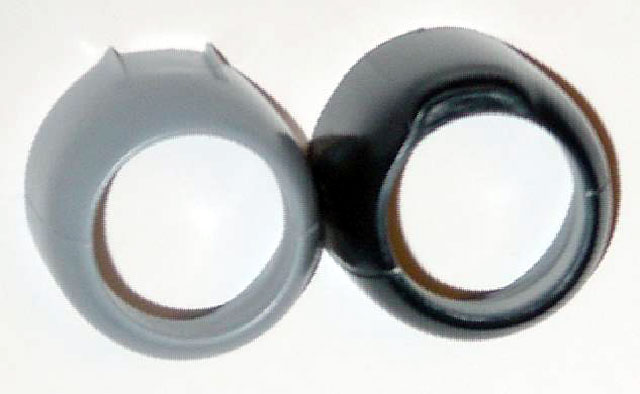
Wheels
This is the only A-26A modification kit that includes
correct main and nose wheels – always one of the main stumbling blocks in
the past from doing a Nimrod model. The main wheels and brakes were the
same as those used on the KC-135. The wheels have “starter holes” that
must be drilled out to accommodate the axles of the kit parts.
(Separately, Meteor also offers a $4 white metal nose wheel strut
replacement (CEC 48076).

The existing Black Magic set (48007) works pretty
well with the exception that the landing gear side of the main gear is a
tad too small. Meteor indicates they will probably release a new BM set
for the update kit.
Nose
The eight-gun nose originally released as CEC 48031 s
included as part of this kit. Forewarned is forearmed—to make the kit
scale out to the correct length you would cut at the panel line in front
of the windscreen. However, to make the kit “look” right it is recommended
that you make your cut 3/16” forward of that panel (do as I say not as I
did!).
Wing Tanks
The A-26A tip tanks have been rumored over the years
to be T-33, A-37 and F-102 wing tanks (it is certainly neither of the
first two).
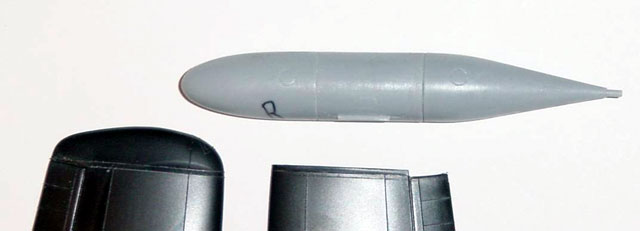
At any rate, careful measurements were made of the
actual tanks an these things are jewels. They are “handed” (marked on the
casting block) so before you cut them free you may want to mark them with
a Sharpie.
Pylons
Once again, these were carefully measured and
accurately reproduced in all three dimensions, even replicating the
openings on the bottom surface and the slight nose down cant of the real
item. (Don’t go opening the holes molded in the wing—the A-26A pylon
spacing was different.)
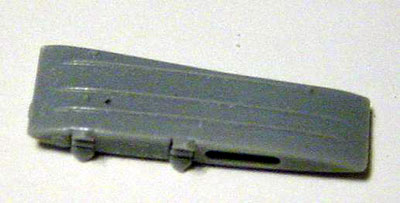
Antennas
There are two trees of various antennas, scoops and
the like that were measured from the original (I was the guy who crawled
around on the real aircraft with my trusty tape measure). The instructions
will include instructions on where to locate them all (the instruction
sheet is all that is keeping the kit from shipping). About the only
comment I have here is that they provide a replacement panel for the
portion of the fuselage where the top turret is located. I don’t plan on
using it; instead, I’ll cut out a disc for the hole and sand down the
turret lip. The reason is that when parked, the bomb bay was always open
and the reproducing that will be easier without using the Meteor part.
(The kit bomb bay has its own “modeling challenges”; the good news is that
the real thing was painted black.)
What Isn't In This Conversion?
Two things: weapons and an interior. Weapons are
coming, including some that you’ve never seen or heard of before: the
M31/M32” Funny Bombs” that were THE preferred munition for the Nimrods.
But more on those when they happen. The other thing is an interior. The
kit interior isn’t bad but doesn’t represent the configuration flown in
SEA. The Nimrods flew with a crew of two sitting side-by-side. However the
kit only provides jump seat on the right side, not a regular seat like was
fitted in the A-26A. (The optional control column fitted in the USAFM
aircraft was not normally found in combat aircraft.) The aft compartment
was fitted with an equipment rack that the kit also lacks. The good news
is that the interior was also painted flat black (except for the chromate
green wheel wells), so depending on the severity of your case of “AMS”,
this may not be a showstopper. Meteor hopes to release a cockpit set soon.
They also plan on doing a decal sheet. In the meantime, there is an Aero
Master sheet available.
I apologize for droning on so long, but I wanted to give you more than a
“Gee, this looks great” review. I hope you have found it useful.
Thanks to Cutting
Edge Modelworks for the review sample
Cutting Edge Modelworks products, including
Cutting Edge Decals,
can be viewed at Meteor Productions
website
Images and Text Copyright © 2003 by
Jim Rotramel
This Page Created on 17 February, 2003
Last updated
14 August, 2003
Back to
HyperScale Main Page
Back to
Reviews Page |
Home |
What's New |
Features |
Gallery |
Reviews |
Reference |
Forum |
Search